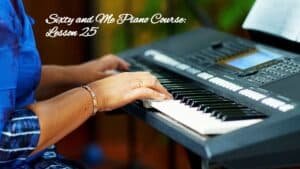
Welcome to Lesson 25, where we talk about music dynamics.
NOTE: If you are just joining us for the first time, you can find my previous Sixty and Me Free Piano Lessons on my Author page. You can join our lessons any time and move at your own pace!
Moving Beyond Beginner
As you move beyond the “beginner” stage, one of the ways to make your piano playing more expressive and “musical” is by adding more dynamics. Dynamics have to do with how loudly or softly you play your music.
If you listen to these performances of the pieces Clair De Lune, or Misty, you can hear a great fluctuation in dynamics. Pianists might or might not observe the dynamics written in their sheet music (dynamics are often not marked at all in popular sheet music, leaving it up to the player) and will always add more than is written on the page.
Musicians might also play a piece a bit different, dynamically, each time they play it, according to their mood at the time. Both of these pieces are also performed Rubato, out of time, which you can do in some classical pieces, and some popular ballads, but we will cover Rubato playing in a later lesson. As you can see, there is much beyond the page for the musician to express!
Use Dynamics to Make Your Music Expressive
Today I want to expand your cache of dynamics so that you can begin to increase the expressiveness of your playing. Experiment with the subtle changes of your fingers pressing on the keys as you strive to play more loudly and more softly. Think about how hard you need to press for forte (f) and fortissimo (ff) and how gently to press for piano (p) and pianissimo (pp) as you play.
NOTE: If you have a keyboard, you can only play dynamically if your keyboard is “touch sensitive,” meaning that the volume gets softer or louder the more gently or strongly you press the key. If your keyboard is not touch sensitive with full-sized keys, I would urge you to upgrade now! You can see my suggestions for inexpensive keyboards here, or look for a used keyboard or piano on eBay, Craigslist, or your local Facebook marketplace listings, etc.
Lots of people want to sell their pianos quickly and cheaply, and pianos always sound better than keyboards (if they are in good condition), in my opinion. But a good touch-sensitive keyboard is great too, and much more mobile!
25.1 The Dynamic Six
There are six primary dynamics that we use regularly, and as usual, they are all Italian terms: pianissimo (pp), piano (p), mezzo-piano (mp), mezzo-forte (mf), forte (f), and fortissimo (ff). Here’s what they mean:
pp – very soft
p – softly
mp – moderately soft
mf – moderately loud
f – loudly
ff – very loud
Watch my video in which I discuss THE DYNAMIC SIX, and how loud is loud and how soft is soft.
It is thought that our default dynamic is mezzo-forte (mf), or moderately loud. Beginners often play a little too loudly because they lack finger control, so be sure to practice your exercises faithfully, to increase muscle strength and finger control. Keep your wrist, arms and shoulders loose and relaxed, even when you are playing forte (f).
25.2 Eine Kleine Nachtmusik, p.74
I love Mozart’s dynamic Eine Kleine Nachtmusik, translated as, A Little Night Music. This is his 1st movement, the Allegro, which means it is to be played fast! But not right away. Start slowly then you can play it faster after you are able to play it smoothly at a slow tempo.
In my demonstration video, listen to the way I change my dynamics as marked in your music. I fluctuate between forte and piano, but the changes are kind of subtle, not too jarring. Never pounding the loud notes, always hearing each soft note.
25.3 Auld Lang Syne
I have also posted some free Auld Lang Syne sheet music for Sixty and Me subscribers to play at the stroke of midnight on New Year’s day (or anytime)! Visit the Sixty and Me page here, then scroll to the bottom left to print Auld Lang Syne.
Passion Practice
- Exercise #4 – Play in B-flat and F with each hand. Try playing Exercise #4 using a metronome set to 3/4 time, at whatever tempo you can play it without pausing.
- MORE DYNAMICS, p.73. Follow the directions for copying the six dynamic symbols for added brain power and memory boosting. Then fill in the letters for the Musical Mind Game below.
- Eine Kleine Nachtmusik, p.74 – Watch my demonstration video 25.2 noticing the dynamics, then play it slowly with the dynamics as written.
- Chord Calisthenics #4, Appendix viii – Play the minor triads from C-minor to F-minor as whole notes, with each hand, then play them in the opposite order, from F-minor to C-minor. Try using a metronome and hold each chord for 4 beats at around 70 bpm. Record yourself to make sure you are staying on the beat!
- Auld Lang Syne or review – play Auld Lang Syne slowly until you can play it at a steady rhythm. There are no dynamics noted on this song, so which dynamics will you use? It’s up to you. Alternatively, you can review Did You Ever See a Lassie on p.62.
Let’s Have a Conversation:
Do you like playing with the different dynamic markings? What is your dynamic? Do you better enjoy playing piano (p) or forte (f)? Are you feeling some increased finger control since starting your lessons 11 months ago? What other improvements are you seeing in your playing? Celebrate your progress! Soon we will begin your second year of lessons!





